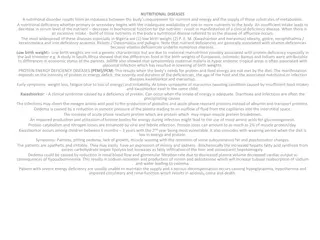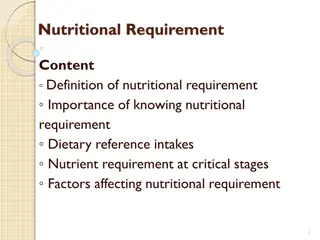Understanding Section K: Swallowing and Nutritional Status Assessment
Section K assesses conditions impacting residents' nutrition and hydration. It covers swallowing disorders, weight changes, and nutritional approaches. Proper coding and care planning are essential for accurate assessment. The section includes evaluation of swallowing difficulties, weight measurements, weight loss/gain calculations, and interventions for maintaining adequate nutrition. Adherence to facility policies and consistency in assessments are crucial for effective care management.
Download Presentation

Please find below an Image/Link to download the presentation.
The content on the website is provided AS IS for your information and personal use only. It may not be sold, licensed, or shared on other websites without obtaining consent from the author. Download presentation by click this link. If you encounter any issues during the download, it is possible that the publisher has removed the file from their server.
E N D
Presentation Transcript
SECTION K SWALLOWING/NUTRITIONAL STATUS January 19, 2016 1-3PM Swallowing Disorders Height and Weight Weight Change Nutritional Approaches
Objectives Understand that Section K is intended to assess the many conditions that could affect the resident s ability to maintain adequate nutrition and hydration Understand how to code Section K correctly Understand what needs to be on the care plan
K0100: Swallowing Disorder Ask resident about difficulty swallowing and each symptom during 7 day look-back period Observe when eating, drinking, or swallowing Interview staff Review medical record
K0100: Swallowing Disorder Do not code if interventions successful Code a symptom even if it occurred only once Check all that apply during 7 day look-back period
K0200: Height & Weight Consistent facility policy and procedure Mathematical rounding, nearest inch/pound A. Height Most recent Admission/Entry or Reentry (If last ht. recorded was more than 1 yr. ago, measure the ht. again) B. Weight Most recent in last 30 days On subsequent assessments, if last recorded weight >30 days prior to ARD, or previous weight not available, weigh again If multiple weights in preceding month, most recent weight Unable to weigh, use Dash (-)
K0300: Weight Loss K0310: Weight Gain Two Snapshots in time: 30 Days, 180 Days New Admission Ask resident, family, or significant other Consult resident s physician Review transfer documentation Compare admission weight to previous weight of 30 & 180 days If less, calculate % weight loss If more, calculate % weight gain
K0300: Weight Loss K0310: Weight Gain Subsequent Assessments Compare weight in current observation period to weight in observation period 30 days ago in observation period 180 days ago If less, calculate % weight loss If more, calculate% weight gain
K0300: Weight Loss Calculate Percentage (5%) in past 30 days Mathematical round weight before calculating Multiply previous weight by 0.95 to determine resident weight after 5% weight loss Example: 160 pounds x 0.95 = 152 pounds A resident whose weight drops from 160 to 152 lbs or less has experienced 5% or more weight loss
K0300: Weight Loss Calculate Percentage (10%) in past 180 days Mathematical round weight before calculating Multiply previous weight by 0.90 to determine resident weight after 10% weight loss Example: 160 pounds x 0.90 = 144 pounds A resident whose weight drops from 160 to 144 lbs or less has experienced 10% or more weight loss
K0310: Weight Gain Calculate Percentage (5%) in past 30 days Mathematical round weight before calculating Multiply previous weight by 1.05 to determine resident weight after 5% weight gain Example: 160 pounds x 1.05 = 168 pounds A resident whose weight increases from 160 to 168 lbs or more has experienced 5% or more weight gain
K0310: Weight Gain Calculate Percentage (10%) in past 180 days Mathematical round weight before calculating Multiply previous weight by 1.10 to determine resident weight after 10% weight gain Example: 160 pounds x 1.10 = 176 pounds A resident whose weight increases from 160 to 176 lbs or more has experienced 10% or more weight gain
K0300: Weight Loss Code whether planned/managed or unplanned/unmanaged Loss of 5% or more in last month OR Loss of 10% or more in last six months Code 0. No or unknown Not experience defined weight loss Prior weight not available Code 1. Yes, physician-prescribed weight-loss regimen Code 2. Yes, not on physician-prescribed weight-loss regimen
K0310: Weight Gain Code whether planned/managed or unplanned/unmanaged Gain of 5% or more in last month OR Gain of 10% or more in last six months Code 0. No or unknown Not experience defined weight gain Prior weight not available Code 1. Yes, physician-prescribed weight-gain regimen Code 2. Yes, not physician-prescribed weight-gain regimen
K0510: Nutritional Approaches Column 1. Column 2. While a Resident 7 day look-back period After admission/entry or reentry While Not a Resident 7 day look-back period Prior to admission/entry or reentry Review medical record for 7 day look-back period All nutrition and hydration received at nursing home, hospital as outpatient or inpatient.
K0510: Nutritional Approaches A. Parenteral/ IV feeding Supporting documentation reflecting need for additional fluid intake for nutrition or hydration or prevention of nutrition need or dehydration. IV fluids or hyperalimentation, including TPN, administered continuously or intermittently IV fluids KVO (Keep Vein Open) IV fluids in Medication Piggybacks Hypodermoclysis and subcutaneous ports in hydration therapy IV fluids to prevention of dehydration
K0510: Nutritional Approaches A. Parenteral/IV feedings do not include: IV medications IV fluids used to reconstitute or dilute meds IV flushes IV fluids administered: In conjunction with chemotherapy or dialysis as routine part of operative or diagnostic procedure or recovery room stay
K0510: Nutritional Approaches - Diets C. Mechanically altered Specifically prepared to alter the texture or consistency of food to facilitate oral intake. Examples include: soft solids, pureed foods, ground meats, thickened liquid. Not automatically a therapeutic diet. Enteral feeding formulas Do not code as mechanically altered diet
K0510: Nutritional Approaches - Diets D. Therapeutic Diet intervention ordered by health care practitioner as part of treatment for disease or clinical condition manifesting altered nutritional status, to eliminate, decrease, or increase certain substances in the diet (e.g. sodium, potassium) Supplements not automatically classify diet as therapeutic Enteral feeding formulas Code as therapeutic diet only if used to manage problematic health conditions (e.g. residents with diabetes)
Scenario Mr. K. has been able to take some fluids orally, however, due to his progressing MS, his dysphagia is not allowing him to remain hydrated enough. Therefore, he received the following fluid amounts over the last 7 days via supplemental TFs while in the hospital and after he was admitted to the NH. While in the Hospital Mon 400cc Tues 520cc Weds 500cc Thurs 480cc Total 1900cc Coding: K0710B1 would be coded 1, 500cc/day or less. K0710B3 would be coded 1, 500cc/day or less While in the NH Fri 510cc Sat 500cc Sun 490cc Total 1500cc
Continued Rationale: The total fluid intake within the last 7 days while Mr. K. was not a resident was 1,900cc (400cc+520CC+500cc+480CC = 1,900cc) Average fluid intake while not a resident totaled 475cc (1,900cc divided by 4 days) 475cc is less than 500cc, therefore code 1, 500cc/day or less is correct for K0710B1, While NOT a Resident. The total fluid intake within the last 7 days while Mr. K. was a resident of the NH was 1,520cc (510cc+520cc+490cc = 1,520). Average fluid intake while a resident totaled 507cc (1,520cc divided by 3 days). 507cc is greater than 500cc, therefore code 2, 501cc/day or more is correct for K0710B2, While a Resident. The total fluid intake during the entire 7 days (includes fluid intake while he was in the hospital AND while he was in the NH) was 3,420cc (1,900c+1,520cc). Average fluid intake during the entire 7 days was 489cc (3,420 divided by 7 days). 489cc is less than 500cc, therefore code 1,500cc/day or less is correct for K0710B3, During Entire 7 Days.
Care Plan Considerations State what swallowing/eating problems the elder has and interventions to prevent complications Provide what interventions are in place to prevent weight loss. This needs to be looked at on admission in order to prevent any weight loss. Include what the dietitian recommends. Also include interventions for any significant weight gain
Care Plan Considerations continued If tube feeding is required be specific with the care needed This is also where you would put there favorite foods, when they want to eat, the foods they dislike, and what they want for snacks and when Always remember to care plan expected weight loss, example weight loss is expected D/T diuresis because of fluid retention and use of diuretics.
Questions? I ll take the next few minutes to answer any questions you might have
Thank you!! Please feel free to contact me Shirley L. Boltz, RN RAI/Education Coordinator 785-296-1282 shirley.boltz@kdads.ks.gov























